|
Spring 2007
Maintenance and Preparations |
The
newest updates are at the top of the page; please
click here to go the bottom of the page
to begin at the--well--beginning.
|
June 4 & 6, 2007:
Launching
Bad weather on Monday, June 4
caused me to cancel the launching--but not until we reached
the public ramp in Rockland and could truly see the
conditions. What a pain. Fortunately, I was able
to reschedule for Wednesday, June 6.
Please
click here to read all about
the launching.
|
June 2, 2007
After a couple weeks where I didn't really do that
much on the boat--since she was more or less ready for
launch--I spent a couple days taking care of the final
pre-launch projects, such as loading cushions, sails, and
other gear on board, installing the anchor rollers, anchor
rodes, and anchors, and taking care of a few minor chores.
Then, on Saturday I rigged up
the mast with its halyards and stays, a process that took
several hours including securing the mast to the pulpits for
transport on Monday. I also washed the decks one more
time to rid them of grime from the past month.
With that, the boat was
ready for launch. All I had to do was put the boom on
deck. |
|
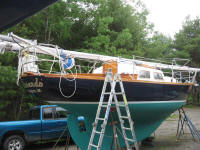
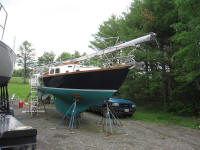
|
May 11, 2007
Last week, I rescheduled my launching date for June 4--not
because I wanted or needed to go in later, but because I
came to the conclusion that I really wanted to stick with
Steve for my boat moving, and just wasn't comfortable with
the other arrangements I had made.
The boat is basically ready
to go in now, though I still have a short list of projects
that I hope--and expect--to get done over the next few
weeks. The late launch date is truly relaxing and
luxurious, in a way. And, frankly, sailing season
doesn't get going up here till June anyway, as much as it'd
be nice to extend it. But early launches tend to lead
to disappointment, non-use, and, all too often, nasty spring
storms to worry about. So while I am still bothered by
the (gasp!) June launching date on some level, it is
actually working out extremely nicely for me this year,
particularly with so much going on at work and with the
house, and with the whole new boat relocation thing
happening.
|
May 8, 2007
Contain your excitement: today, I varnished the other
side of the coamings, and I don't even have pictures to show
you!
|
May 6, 2007
Over the weekend, I installed the stanchions and lifelines,
and fabricated new chainplate deck covers to replace the
old, which were a few years old and needed rebedding.
Since commercially available plates don't fit in the space I
have, I have always built simple 1/4" thick sections of
mahogany with slots cut out for the chainplates. After
removing the old ones, I bedded the new ones with a heavy
glop of polysulfide.
Sunday, I decided to paint the
bottom and get that out of the way. In a few days,
I'll move the stands and paint the areas that I couldn't get
during the first round. |
|
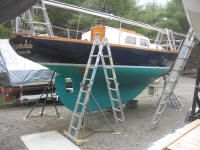
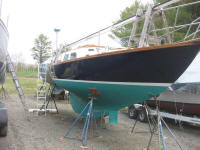
|
May 1, 2007
Last weekend, I spent part of Saturday afternoon working on
the engine--first an overall inspection, then reassembly of
the water pump, and finally a test run. Not
unexpectedly--yet still somehow surprisingly--the engine
started immediately, as if I had only shut it down a few
minutes earlier rather than a year and a half ago. The
Yanmar is always a champ. I ran the engine for some
minutes, confirmed that the charging system was working
properly, and enjoyed the moment.
Sunday, I carted load after
load of gear down from the attic so that it would be readily
accessible for loading and inspection. I also
reorganized my fastener box, as I had picked up a new
storage system to replace the heavy, unwieldy, and
inefficient large tackle box that I had used before.
The old box, still containing larger fasteners and other
random spare parts, would need to remain on board, but now
the basic screws and bolts that I'd typically need for
maintenance or repairs would be better organized for easier
use.
Tuesday, I sanded down the
coamings, lazarette hatch, and tiller, and applied a coat of
varnish to all (one side of the coamings only at this time,
of course). All were in good condition and required
only maintenance coats. After I have a chance to apply
a coat of new varnish to the other side of the coamings in a
few days, I'll reinstall these pieces on the boat where they
belong. |
|
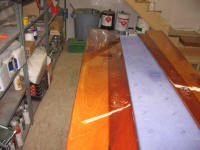
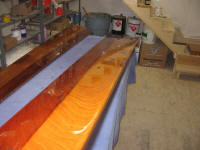
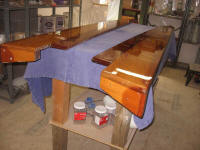
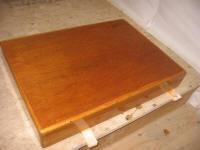
|
April 27, 2007
The great stretch of weather continued through Wednesday,
allowing me to get 5 coats of varnish on the toerails.
I needed to take down the staging Wednesday afternoon for
use in
the shop again after my short break, but at least I
now had enough varnish on the toerails to take the pressure
off. With luck, I'll manage a few more coats sometime
between now and launching, but there's enough to last the
season if it absolutely had to.
There's still varnish work
required on deck, in areas that I can reach without staging.
And there's a host of engine maintenance tasks ahead,
including fuel and oil filters and a careful inspection,
since the engine hasn't run since September '05.
Launching date is May 29,
the day after Memorial Day. We'll see how that all
goes, with an untested hauler and a new boatyard for mast
stepping. |
|
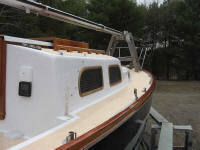
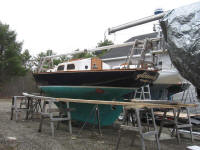
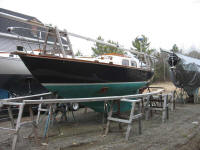
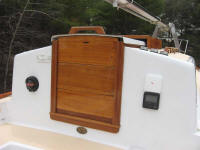
|
April 23, 2007
I had many errands to run today, taking advantage of one of
the few days off I allow myself during the week, thanks to a
brief period of downtime before my next work project began
later in the week.
Among my errands was a trip to Ed's Batteries to replace my
aged trio of boat batteries. The two Trojan T-105s and
single Trojan starting battery had served me well since
2001, but I had noticed some decrease in performance during
our last sailing season in 2005, and last year, 2006, was
the kiss of death for the batteries; I had hooked them up
and left them aboard during the summer to allow the bilge
pump to drain any rainwater, but never paid them much
attention, and they wouldn't take a charge now.
I replaced them in kind
with a new pair of T105s and a new Trojan 24SM850 starting
battery. The price on the T105s had increased
substantially since I bought the first pair.
When I got back to the boat
late in the morning, I installed the new batteries--always a
fun chore on this boat, given the limited access.
Then, I sanded the toerails and sea hood top again (the sea
hood sides were in good condition and needed only
maintenance coats, which I'll apply once I build up several
base coats on the top) and applied more varnish. It
was extremely warm today--in the 80s, which set records
across the state. Too hot for varnish, really, but
since they were base coats I didn't worry too much about it.
I took these photos early
the next morning after a brief rain shower. |
|
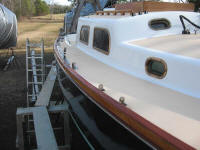
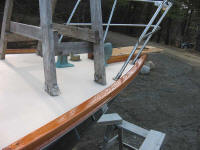
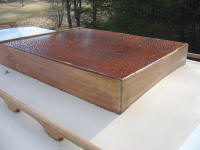
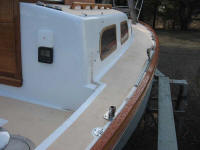
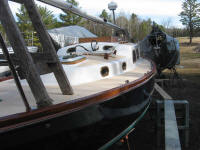
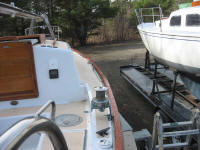
|
April 22, 2007
With clear skies yet again and more warm temperatures, I
decided this morning to get the bronze port frames
refinished and over with--a more or less annual ritual,
though I didn't touch them during last year's "season of
neglect", and they were in surprisingly good condition this
spring--though with flaking lacquer in some areas they
clearly needed to be refinished. These two photos
showing the beginning condition are pretty poor...sorry. |
|
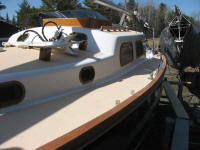
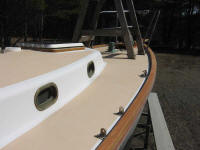 |
| As usual, the preparation
and masking took far more time than the actual work. I
began by masking off the inside and outside of all the
frames, after which I sanded them with 80 and 220
grits to remove flaking lacquer and clean them up a bit.
As usual, I didn't obsess over this; I like the old patina,
and have never spent huge amounts of time on prep. I
go for the aged, yet bright, bronze appearance.
Next came my favorite
part--and by far the most annoying and time-consuming:
applying masking paper around all the ports so that the
spray lacquer wouldn't coat the adjacent surfaces.
This took forever...plus, I don't get the newspaper anymore,
and therefore had little in the way of material to use for
the purpose. I began using paper that had been used as
packing material in some boxes I had recently received, but
the paper was in poor shape and tore easily--very
frustrating. Then, I happened upon a large roll of red rosin
paper left over from the house construction, and this worked
well for the remaining ports--although it was far heavier
than required for the job.
With all the ports finally
masked off--I rushed to try and beat the wind--I applied
several coats of exterior spray lacquer to all the ports.
At this time, I only did the eight ports I could reach from
the staging; the two forward-facing ports in the saloon
could wait till later. But I had a limited amount of
time before I'd need the staging back in the shop for my
next work project, so I concentrated for now only on
those areas for which I truly needed the staging. |
|
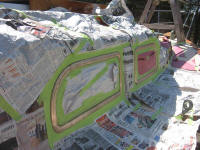
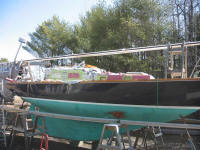
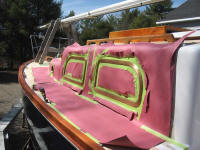
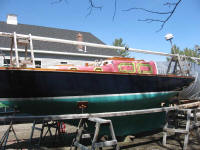
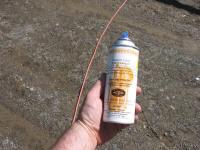
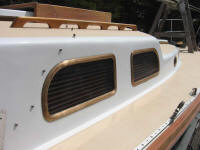
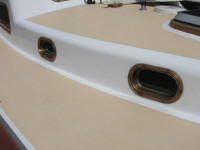 |
| Once the lacquer was dry,
I sanded the toerails with 320 grit to prepare them for more
varnish. Then, I stripped the top of the sea hood,
using first the carbide scraper and then a DA sander with
120 grit. The loose and flaked varnish came off
easily, of course, but the remaining varnish--probably 15-20
coats' worth--was surprisingly difficult to remove. It
was a foregone conclusion that the mahogany plywood veneer
forming the top of the sea hood would probably be
compromised during this process, since there were already a
few areas near the edge where I had sanded a little too much
during the original construction. The top was in such
poor condition that I figured I'd do what I could, and hope
for the best.
I ended up with a few thin
spots in the veneer, but there wasn't much I could do about
that. I hoped the overall effect would be minimal in
the end, but I was already mulling over ideas for redoing
the top of the sea hood without needing to rebuild the whole
thing. That would come later, though.
It was warm in the sun, and
the first coat of thin varnish I applied to the sea hood
dried quickly, so I applied a second coat later in the day.
Then, I applied the second coat to the toerails.
|
April 21, 2007
The weather was gorgeous, and unseasonably warm, and I got
right to work on the toerails this morning. The
toerails--particularly their top, horizontal edges--were in
horrible condition, with the varnish severely crazed and
worn away, and clearly my only route was to strip them
completely. IN addition, some of the other brightwork
on board was in similarly poor condition, particularly the
sea hood top (which had been declining for the past couple
seasons anyway). But overall, the toerails represented
the most work.Using
a carbide scraper, I scraped off the varnish from the top of
the toerails and from the inside portions as well, which
were also suffering from neglect and showed many areas where
water had gotten behind the varnish, lifting it in sheets.
The exterior portion of the rails, however, were still in
sound condition, and I didn't bother stripping them to bare
wood, choosing instead to simply sand them thoroughly. |
|
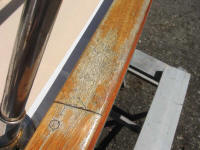
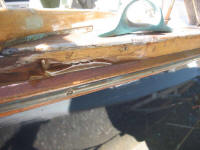
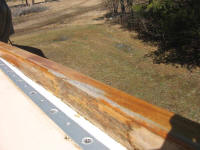
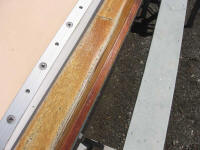
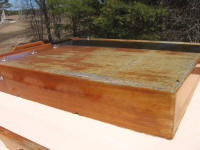
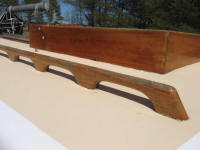
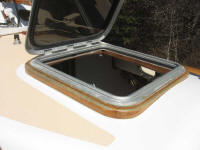 |
| It was amazing to see how
one year of neglectful maintenance can begin ruining a boat.
With no time to spare last year, I didn't do anything on the
boat at all, and things had really gone to seed. It
was depressing, but I was energized to start the restoration
work. Once I had
stripped off the varnish with the scraper--which went quite
easily for the most part--I sanded the toerails with 80,
120, and 220 grits, using a sanding block where possible and
finishing with hand sandpaper for the rounded edges and
tight spots. I was pleased to find that the rails
cleaned up nicely, with no staining. |
|
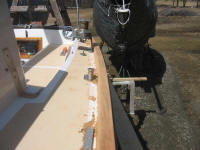
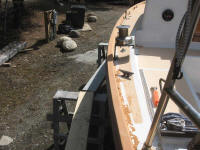
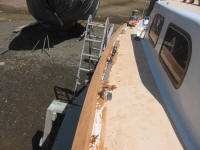
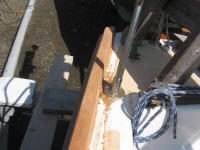

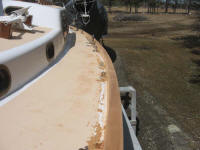 |
| Next, I masked off the
deck and the brass rubrail, and applied the first coat of
varnish to the bare wood, using a thinned-down mixture to
best allow it to soak in. And thus began a long
process of building up as many coats as I could during the
unpredictable spring weather. |
|
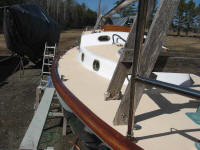
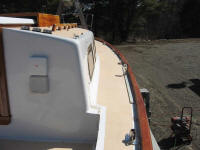
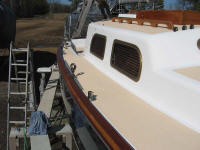
|
April 20, 2007
Although my decision to not put the boat in the water last
season was the right one, given the amount of time I spent
building our new house, it was still difficult to go a full
year without the boat, and I was starting to really look
forward to this season's boating.
Because of travel plans, we
pulled the boat early at the end of the 2005
season--September 9, in fact. So it had been a long
time since she was in the water--by the time we reach our
scheduled launch date of May 29 this year, it will be 627
days.
April didn't work out well
at all for boats, since we had two late-season snowstorms
(14" and 6") during the first two weeks of the month,
followed a week later by the so-called "Patriot's Day" or
"Tax Day" northeaster, which brought high winds and heavy
rain.
So, much later than usual,
I finally managed to uncover the boat today. It was
pleasantly warm, and I pulled the cover off early in the
morning before the wind had time to pick up. Later in
the day, I removed the framework and chafe gear, as well as
the cockpit coamings so that I could refinish them inside.
Fortunately, the coamings were still in good condition and
required only maintenance coats of varnish. |
|
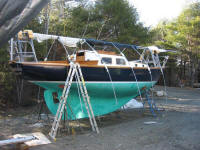 |
| First and foremost on my
work list for the spring was a substantial bath: both
above and belowdecks. I had washed the boat last
September before putting on the cover--she was filthy then
after her long summer of non-use--but winter is always tough
on the boat, and before I could do anything else I had to
start with a clean canvas. So I scrubbed the decks and
hull, and then cleaned up below, cleaning all the
countertops, woodwork, and lockers. Much better.
With that done, I set up some
staging around the boat so that I could get to work on the
most important job for the spring: refinishing the
toerails (and other brightwork. |
|
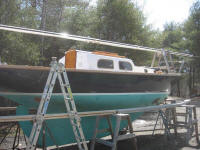
|
|
| |
|